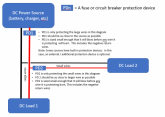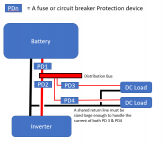FilterGuy
Solar Engineering Consultant - EG4 and Consumers
I am starting this thread to discuss Fuse/Circuit Breaker Sizing and placement.
Edit: Updated the rule of thumb based on feedback in a later post from @JoeHam
My rule of thumb is the protection Device should be the lower of 1) The capacity of the power source or 2) 1.25 x the expected current on the wire.
Edit: Added info about wire sizing and Fuse Size.
All of the circuit (including the return) must use wire that is large enough (or larger) to handle all of the current the fuse will allow.
Note that adding fuses that are larger than needed means you must also use wire that is larger than needed.
This is large enough to prevent nuisance trips/blows but will still offer adequate protection.
I have noticed others use a different rule of thumb, so this might be an interesting discussion.
The following several posts are based on how I decide where protection devices need to be placed.
Edit: Added the following:
Here is a link to the slide deck in case someone wants a copy.
Edit: The deck was updated on 2/20/2020
https://docs.google.com/presentation/d/1720u-tB3Ey3bvsO4Itk3pmpdhtBdpd14ViiNGqX4U1o/edit?usp=sharing
Edit: Updated the rule of thumb based on feedback in a later post from @JoeHam
My rule of thumb is the protection Device should be the lower of 1) The capacity of the power source or 2) 1.25 x the expected current on the wire.
Edit: Added info about wire sizing and Fuse Size.
All of the circuit (including the return) must use wire that is large enough (or larger) to handle all of the current the fuse will allow.
Note that adding fuses that are larger than needed means you must also use wire that is larger than needed.
This is large enough to prevent nuisance trips/blows but will still offer adequate protection.
I have noticed others use a different rule of thumb, so this might be an interesting discussion.
The following several posts are based on how I decide where protection devices need to be placed.
Edit: Added the following:
Here is a link to the slide deck in case someone wants a copy.
Edit: The deck was updated on 2/20/2020
https://docs.google.com/presentation/d/1720u-tB3Ey3bvsO4Itk3pmpdhtBdpd14ViiNGqX4U1o/edit?usp=sharing
Last edited:








